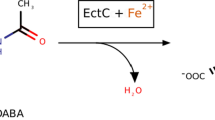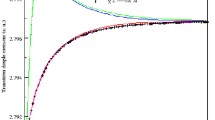Abstract
The active site of rubredoxins, the simplest class of iron-sulfur, electron-transfer proteins consists of a single Fe atom surrounded by a distorted tetrahedral array of four cysteine sulfur atoms. In a previous paper on the oxidized rubredoxins, we calculated the electric field gradient at the Fe57 nucleus, the resultant quadrupole splitting and the hyperfine field due to interaction between the Fe nucleus spins and the net electron spin of the molecular complex. In this paper, we are going to present our calculated results of the same set of properties for the reduced state, using the molecular orbitals similarly obtained from an Iterated Extended Hückel calculation. Significant contribution of the anisotropy to the hyperfine field as well as the sign of the electric field gradient, and hence the quadrupole splitting allow us to pin down conformations which give the best agreement with the experimental results. In fact, the conformation (conformer A) which represents a small movement of one of the S atoms from its crystal structure position in such a way that pairs of S atoms lie in ⊥ planes yield remarkably good results for all the physical properties calculated in both oxidation states. This consistency also suggests that there is no appreciable conformational change through the oxidation process.
Similar content being viewed by others
References
Loew, G., Lo, D., submitted to: Theoret. Chim. Acta (Berl.) (1972)
Phillips,W., Poe,M., Weiher,J.F., McDonald,C.C., Lovenberg,W.: Nature 227, 574 (1970)
Rao, K.K., Evans, M.C.W., Cammack, R., Hall, D.O., Thompson, C.L., Jackson, P.J., Johnson, C.E.: Biochem. J. 129, (1972)
Loew, G., Chadwick, M., Steinberg, D., submitted to: Theoret.Chim. Acta (Berl.) (1972)
Jensen, L.H.: Latest X-ray results received 10/12/72 by private communication
Zerner,M., Gouterman,M.: Theoret.Chim. Acta (Berl.) 4, 44 (1966)
Zerner,M., Gouterman,M., Kobayashi,H.: Theoret.Chim. Acta (Berl.) 6, 363 (1966)
Mulliken,R.S.: J. Chem. Phys. 23, 1833, 2338, 2343 (1955)
Rettig,M.F., Han,P.S., Das,T.P.: Theoret.Chim. Acta (Berl.) 12, 178 (1968)
Loew, G., Chadwick, M., Lo, D., submitted to: Theoret.Chim. Acta (Berl.) (1972)
Han,P.S., Rettig,M.F., Ikenberry,D., Das,T.P.: Theoret.Chim. Acta (Berl.) 22, 261 (1971)
Author information
Authors and Affiliations
Rights and permissions
About this article
Cite this article
Loew, G.H., Lo, D.Y. Molecular orbital calculation of hyperfine interactions, electric field gradient and quadrupole splitting in reduced rubredoxins. Theoret. Chim. Acta 32, 217–226 (1974). https://doi.org/10.1007/BF00527477
Received:
Issue Date:
DOI: https://doi.org/10.1007/BF00527477




